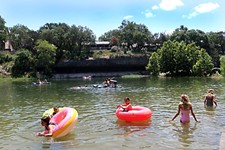Day Trips
Rancho de las Cabras left a legacy of agriculture terms and techniques that survive today
By Gerald E. McLeod, Fri., Aug. 17, 2007

Rancho de las Cabras outside of Floresville helped start the ranching industry in Texas. As a meat-producing arm of the San Antonio missions in the 1700s, the "Ranch of the Goats" left a legacy of agriculture terms and techniques that survives today.
At the peak of the Spanish mission period in Texas, there were at least six ranchos around San Antonio. Once a month, a ranger from the National Park Service unlocks the gate to visitors for an hourlong tour of the former ranch headquarters site. The rest of the time it is a laboratory for archaeologists.
"We're just happy that we have found one of the former ranch sites," says Dan Hollifield, a ranger usually assigned to Mission San José.
The missions were self-sustaining villages intended to turn the native Texans into taxpaying citizens of the Spanish crown. After a lack of success with the Indians in East Texas, four missions – Concepción, San José, San Juan, and Espada – were moved to the San Antonio River downstream from the older and more famous Mission San Antonio de Valero, more commonly known as the Alamo.
Each of the missions grew vegetables outside its walls and had ranches off in the distance. Established around 1745, Rancho de las Cabras was the livestock operation for Mission San Francisco de la Espada, the southern-most settlement in the chain.
Government and church inspectors left ledgers full of descriptions of the ranch. At one time the vaqueros had hundreds of sheep, pigs, horses, and 1,200 cows on the 20,000-acre spread. The remnants of the compound are the last physical reminders of a 2-acre fort built to protect the ranch inhabitants from marauding tribes.
"Being a cowboy back then wasn't a very high status," Hollifield says. "They were considered herders." The diamond-shaped fortress with red sandstone walls enclosed corrals, huts, and a small chapel. Once a week, a herder drove six cows the 30 miles to Mission Espada.
By 1794, the Spanish government secularized the church property and began settling immigrants on the mission properties. The rancho passed to Ygnacio Francisco Xavier Calvillo, a Canary Islander who settled in San Antonio. When Ygnacio was killed by bandits, the ranch operation was taken over by his daughter María del Carmen Calvillo.
Doña María became a strong influence in Texas, until her death in 1856, by supporting laws that ensured women could inherit, own, and operate businesses in their own names. She expanded the size of Rancho de las Cabras and added irrigation, crops, and a mill. Her descendents still live in the area.
In 1976, the Texas Parks and Wildlife Department acquired 99 acres around the old ranch buildings. Without funds to preserve the crumbling rock walls of the compound, the state Parks Department buried the ruins in sand to prevent further erosion and vandalism. In 1995, ownership was transferred to the federal park service.
"We're not doing much better than Texas Parks did," says Susan Snow, the lead archaeologist on the project for National Park Service. The outline of the walls is discernible only by the weed-covered mounds that encase the ruins. Volunteers are sifting through the dirt of 1-meter-square holes dug in the soft layers of dirt. "We're trying to find what we have to interpret for visitors," Snow says, "without destroying anything." Currently, no plan calls for making the site more accessible to the public.
Don't go to Rancho de las Cabras (often mistakenly called the Mission de las Cabras) expecting to see impressive ruins. What visitors see is a working archaeological dig, and they'll hear the stories of the birthplace of the ranching industry where the events took place. Tours leave Floresville River Park at 10am on the first Saturday of each month. For more information, call the ranger station at Mission San José at 210/932-1001. High-clearance vehicles are needed to reach the site.
For information on joining archaeologists from the University of Texas at San Antonio and the NPS for Saturday excavations at Rancho de las Cabras, go to car.utsa.edu or call 210/458-4378.
Start a visit of the San Antonio missions at Mission San José, 2002 Roosevelt. It was once called the queen of Texas missions.
842nd in a series. Day Trips, Vol. 2, a book of "Day Trips" 101-200, is available for $8.95, plus $3.05 for shipping, handling, and tax. Mail to: Day Trips, PO Box 33284, South Austin, TX 78704.








